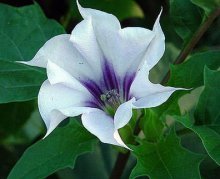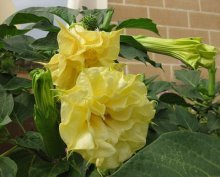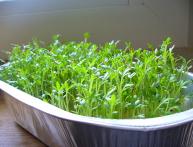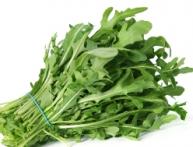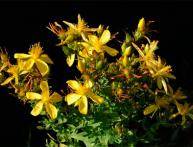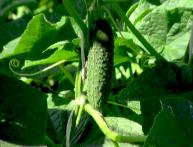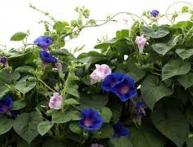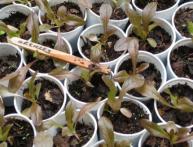How to grow and care for datura
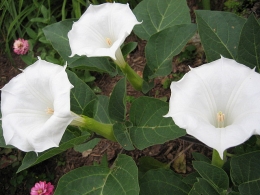
Datura is an unusually beautiful plant, whose white flowers will decorate any garden.
Plant with its subtle intoxicating aroma, it used to be called datura grass. This is a very poisonous plant, so you should be very careful when placing a flower in your garden.
Datura is easy to grow and care for. Even a novice florist can cope with this.
Content:
Plant characteristics

Datura is a herbaceous annual plant belonging to the Solanaceae family. It can reach up to 1 meter in height.
The plant has a taproot and a branched root. Datura leaves are large, egg-shaped and arranged alternately. The leaf blade is light below and darker above.
The Datura fruit looks like a box, which is densely covered with thorns on top. When the fruit ripens, the box opens into 4 doors.
The flowers of Datura herb are pale white, large and single, fragrant, bell-like. Flowers can also be yellow, pink, violet or purple.
They can be located in the leaf axils or at the top of the plant. The peculiarity of the datura is that the plant blooms for only one day, and the beautiful flowers bloom only in the evening.
About 15 buds bloom every day. In order for the plant to delight with its beautiful flowers, you should regularly cut off flowers that have already bloomed.
The plant begins to bloom from July until frost. There are several varieties of Datura.
Datura Indian. This is a perennial plant with a high level of branching. Flowers can be of different colors.
Datura common. Belongs to the annual category. The root system is powerful and branched. The flowers have a distinct aroma.
Datura is harmless. This annual plant is absolutely harmless. The corollas of the plant are fragrant and have wide-angled reflexing lobes.
Features of growing datura grass
Datura is grown in loose and nutritious soils. A place for growing dope should be chosen that is sunny and protected from the wind. Growing process Datura is uncomplicated.
First you need to prepare a soil mixture for sowing seeds. It is better to harvest it in the fall. To prepare the mixture, you need to take the following components in a 2:2:1 ratio: sifted garden soil, humus and coarse river sand.
Sowing seeds in open ground is carried out in May, and for seedlings - in March. Planting material can be checked for germination in advance.
To do this, pour all the seeds into a separate container and fill with hot water. Seeds that have begun to float are not suitable for sowing.
You can sow seeds to obtain seedlings in any container. Then cover with plain paper and place in a dark place for germination. The first shoots will appear within a week and the container can be moved to a lighted place.
Seedlings can be planted in the ground after frost in May or early June. Since the datura loves space, distance from seedlings should be about a meter. Datura can be grown and propagated by cuttings.
To do this, in September you need to cut a cutting on which 2-3 pairs of leaves will be located. It is rooted in water or in soil.

Those plants that have taken root can be planted in open ground in May. After planting, the plant begins to bloom within 3-4 weeks.
Some gardeners grow datura as a perennial plant, i.e. transferred indoors for the winter. In this case, you can root throughout the year.
How to care for a datura
It is very simple and easy to care for the datura, you just need to know and follow some recommendations. Then the plant will bloom constantly.
The plant is poisonous, therefore all operations for caring for dope must be carried out with gloves.
To ensure lush flowering, datura grass must be fed with complex mineral fertilizers once a week. It is recommended to fertilize from the moment of planting.
Datura grass should be watered every other day, and on very hot days - daily. To prevent water from stagnating, you should regularly monitor the soil.
For indoor datura, watering in winter should be reduced, since it is at this time that the dormant period begins. The indoor plant loves a lighted place. In winter, the datura must be moved to a cool room.
An important condition for the active growth of dope is pruning. It is necessary to constantly remove faded heads.
In autumn, when the flowering period has already stopped, the branches of the datura should be cut off so that the crown of the plant is formed. New Datura flowers will grow on new young branches.
The plant is enough pest resistant and diseases. In rare cases, Datura can be affected by spider mites and whiteflies.
Datura is a very ornamental plant. Thanks to its lush multi-colored flowers, it can be used to create various flower bed compositions.
Video, characteristics of the plant Datura (Datura):
Interesting information about the vegetable garden

